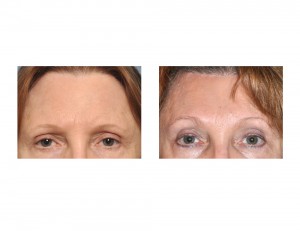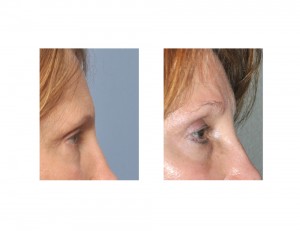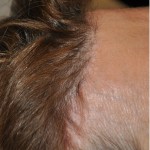Background: Aging of the face affects all structures but none are more noticeable, both early and late in the process, than that of what occurs around the eyes. One of those changes is a sag or lowering of the eyebrows. Due to frequent motion of the muscles which often pulls them down and the long-term effects of gravity, the eyebrows can lower from their original position on the brow bones. A lower than normal eyebrow position not only affects how we look but can make redundancy of upper eyelid worse.
The treatment of brow ptosis (brow sagging) can be done by a variety of techniques, most of which are based on some type of superior scalp incisional approach. The traditional full coronal incision of yesterday has been largely replaced by a much more limited endoscopic technique. With smaller incisions and a quicker recovery, the endoscopic browlift can be applied even to younger patients with smaller amounts of brow sagging.
But the endoscopic browlift is not perfect and the benefits of the smaller incisions are offset by the limits of what the procedure can do. Besides restrictions on how much of the forehead muscles can be manipulated, its lifting effect is based on an epicranial shift concept. Because no tissue is removed, the browlift effect is created because the scalp is moved backwards. As the scalp tissues a removed back, the forehead is pulled upward with the brows at the lower end being pulled with it. While the brows may be lifted, the forehead also lengthens. This may be aesthetically disadvantageous for the patient who already has a long forehead.
An intermediate browlift technique between a coronal and endoscopic method is the pretrichial or hairline method. This less frequently used browlifting method has many of the advantages of other browlift techniques with the only disadvantage of how well the hairline scar appears.
Case Study: This 62 year-old female was undergoing a variety of facial rejuvenation procedures. One of them was her desire to give her eyes a less tired look. She already received Botox injections in the glabellar region and felt that if her brows were lifted, particularly the middle and outer areas (which Botox did not lift very much) then she would have a less tired and worn appearance.



Case Highlights:
1) Brow lifts can be done by a variety of techniques of which the hairline or pretrichial approach offers a balance between a relatively hidden scar and a powerful brow lifting effect.
2) The amount of skin removed along the frontal hairline correlates closely with the amount that the brows are actually elevated.
3) The scar along the frontal hairline can have some hair that grows through it with a small amount of hypopigmentation.
Dr. Barry Eppley
Indianapolis, Indiana


